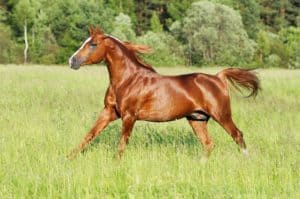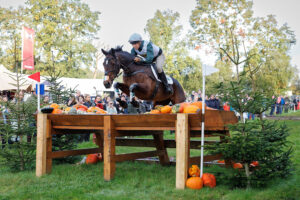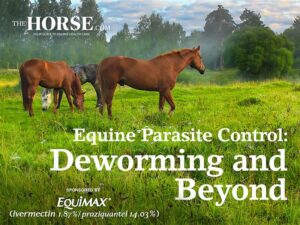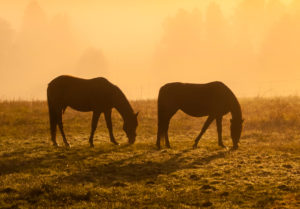It’s All in the Genes: Horse Traits and Heritability
Scientists are continuing to uncover which genes are responsible for certain traits in horses

What are you drawn to in a horse? A flashy coat color? A puppy dog personality? Smooth-as-molasses gaits? Well, your dream horse didn’t come by these traits by happenstance. Many characteristics such as coat color, height, athletic ability, and behavioral tendencies are genetic in nature. And researchers are using “genomics,” the study of gene heritability, structure, and function, to determine which characteristics are connected to which genes.
Before getting into the fun stuff, let’s break down the terminology. The genome includes all DNA that goes into an individual from sperm pairing with an egg. Every cell contains DNA in the form of chromosome pairs—except for gametes, or sex cells, which just have one chromosome.
Each strand of chromosomal DNA is made up of organic molecules called nucleotides (guanine, cytosine, adenine, and thymine). Their sequence leads to differences in the traits the individual displays—for example, coat colors.
Differences in the genomic DNA sequence between individual horses are called single nucleotide polymorphisms (SNPs, or “snips”). If SNPs are located near each other on a chromosome, they will likely be inherited together; this proximity enables researchers to investigate specific regions of the genome that vary in frequency between horses.
Samantha Brooks, PhD, assistant professor and founder of the University of Florida’s Brooks Equine Genetics Lab, in Gainesville, says SNPs aren’t the only reason for genome variation. Much of it is also due to sequence rearrangements or changes. “Genes that have flipped or duplicated may be responsible for variation in phenotype (observable characteristics),” she says.
For instance, a sequence change is responsible for tobiano color (white hair on a base coat color) in pinto horses, says Brooks. While most rearrangements are benign, some are fatal, such as the overo lethal white gene responsible for a disease that suppresses intestinal activity.
Let’s look at some of the harmless (and even desirable!) genetic variations that create horses’ unique characteristics.
Coat Color’s Link to Behavior
You’ve probably heard people describe chestnuts, or “redheads” as they’re fondly called, as excitable and reactive. It turns out there might be some biological truth to this stereotype, says Brooks. In one study in humans, researchers compared pain responses in redheads to those of nonredheads. Subjects rated their pain in response to small electric shocks from electrodes attached to their shins. The researchers then administered an analgesic (morphine) and asked the participants to rerate the pain. The redheads consistently perceived the electrical shocks as more painful than nonredheads did, but they reported relief from analgesia.

It turns out that both people and horses have mutations in the MC1R (melanocortin receptor 1) gene. This gene is responsible for signaling cells called melanocytes to produce the pigment melanin and establish base coat color. Redheads (both human and horse) have a variant of this gene that prevents them from producing the black pigment and allows them to produce only red pigments. In humans the MC1R loss-of-function mutation results in red hair, along with increased sensitivity to the sun and a lower pain tolerance. In horses, a similar mutation produces a chestnut coat color.
“The melanocortin receptors in the brain are in part responsible for translating a signal from that opioid class of chemicals (which the brain produces and uses for signaling), and the same receptors on melanocytes are responsible for receiving signals for when to turn black pigment on or off,” Brooks explains. “This mutation in both chestnut horses and redheaded women creates a defective receptor that doesn’t receive a signal for pigment control or for pain relief.” This might make a chestnut-coated horse more sensitive to environmental stimuli.
Another base coat color gene, ASIP (agouti-signaling protein), is associated with behavior in horses. The ASIP gene works in the same signaling pathway to suppress the effect of the MC1R gene. Brooks and her colleagues surveyed owners of 215 Tennessee Walking Horses to compare 20 temperament traits with DNA information extracted from the base of their hair follicles. Horses with a loss-of-function mutation in ASIP, which results in a black coat color, tended to have more self-reliant and independent temperaments than those with bay coats. This particular mutation might also keep the adrenal gland from releasing natural steroid hormones in response to stress, thereby leading to a calmer temperament.

Spooking and the Startle Response
You’ve always known your spooky gelding is a bit of a scaredy-cat, but did you know he might be genetically wired to react to things the way he does? University of Florida researchers recently studied Quarter Horse weanlings to map the genes for spooking behavior.
“The initiation of a spook begins with a startle response, which is a neurologic reflex, not a conscious effort,” Brooks says. “Some genetic changes result in an alteration in the neurologic pathway controlling the startle response.”
All study horses received uniform environmental training (e.g., they were halter-broke at the same time, etc.). All also experienced the same experimental setup: Once the weanlings were accustomed to being fed from a pan in a round pen, a researcher would pop open a brightly colored umbrella nearby while they ate. The team catalogued the responses—ear flick, increased heart rate, defecation, distance traveled, and the likelihood and speed of return to the feed pan. Some weanlings continued eating, some refused to return to the feed pan, and others exhibited behaviors across the spectrum. The researchers used a statistical model to score each individual’s likelihood to startle.
“To map something, you must first be able to precisely measure it,” says Brooks. Now the researchers will investigate each weanling’s genetic makeup and look for genomic markers that correlate with its score.
“A practical objective of this work is to create a genetic test for the tendency to spook, based on a population-wide average,” says Brooks. “Recreational riders often want a quiet horse, whereas a show jumper may desire a horse with lightning-fast reflexes. A DNA sample submitted for genetic testing may help people decide if a young horse will be appropriate for their athletic endeavors.”
Along similar lines, Ann Staiger, MS, PhD, a recent graduate of Brooks’ team, is conducting an ongoing experiment with Tennessee Walking Horses to map the genetics responsible for tractability and for willingness to load on a trailer.
Genes for Speed
Historically, breeders have had to rely on conformation and progeny performance records to predict a physical trait’s heritability. Advances in technology and gene identification have led to the availability of tests that help determine if the sire and/or dam has actually passed on specific genetic markers for performance. With potentially better odds of acquiring a highly talented horse, there has been much interest in identifying genetic variables that impact racing performance.
Ernest Bailey, PhD, professor at the University of Kentucky’s Maxwell H. Gluck Equine Research Center, in Lexington, is involved with The Horse Genome Project. He says several laboratories have investigated racing performance and the MSTN (myostatin) gene. They have identified two alleles (different forms of a gene at one chromosome location) on the MSTN gene—the T-allele for distance and the C-allele for sprinting. The T-variant is common in Arabian lines that produce successful endurance horses. In contrast, Quarter Horses have a high frequency of the C-allele for sprinting, whereas Thoroughbreds have a mix of the two.

Researchers have found that myostatin mutations are associated with increased muscling, distribution of fast-twitch muscle fibers, and hindquarter power. Practically applied, looking at pedigrees of Thoroughbreds that excel as 2-year-olds in elite middle-distance (8- to 12-furlong, with a furlong being 1⁄8 mile) races, common sires include great 20th-century stallion Nearco and his sons Nearctic, Nasrullah, and Royal Charger. All these horses’ genes contain the C-allele of the myostatin gene, which confers early muscling and speed in 2-year-olds. The myostatin gene profile can help predict an individual’s best distance, but researchers caution not to consider it a speed gene or use it to define a horse’s racing class.
The Genes Behind Gaiting
Gaited horses rely on the “gait-keeper mutation,” DMRT3_SER301STOP, to maintain their gaiting at high speed without breaking into a canter. Horses with this mutation tend to use intermediate (i.e., trotting or pacing) gaits more frequently, says Brooks.
“Racing performance and gait are much more complex than can be explained by a single gene, but this gene has a major impact on gait,” says Bailey.
In a 2014 evaluation of breeds worldwide, Swedish researchers found this mutation in 68 of 141 breeds. It was most common among gaited breeds or harness racing horses and often absent in other breeds. Bailey says selection for it has enabled its spread in Standardbreds, Saddlebreds, Missouri Fox Trotters, Paso Finos, Icelandic horses, and Kentucky Mountain Saddle horses, to name a few.
Height’s Link to “Roaring”
Researchers have noted a positive correlation between Thoroughbred racehorse height (and leg length) with earnings. But breeding pressure to instill the “tall” gene might have created unintended consequences. Scientists have now identified a link between height and the respiratory condition recurrent laryngeal neuropathy (RLN, or “roaring”) in Thoroughbred racehorses and in draft horses. In a 2014 study out of Michigan State University, the authors demonstrated “a significant association of RLN with the LCORL /NCAPG locus (the position of a gene on a chromosome) on equine chromosome 3 previously shown to affect body size in horses.” This same location is known to have a significant effect on Thoroughbred withers height.
“Genes are strung along the chromosome like pearls on a necklace,” says Brooks, reflecting on SNP proximity. “Those that are nearby to one another will tend to stay together and aren’t often separated by the process of recombination,” which produces offspring with combinations of traits different from those found in either parent.
“If selective breeding increases the frequency of the tall gene, and if it sits on the same chromosome as the neuron-affecting gene, then there may be a simultaneous increase in both frequency of height and for a disease like roaring,” she says.
More research is needed to determine the RLN and height genes’ actual proximity or if they are the same gene performing two unique functions, says Brooks.
Take-Home Message
Genomic science can help breeders decipher a horse’s potential appearance and performance qualities. These are only a few of the current projects geneticists are working on involving equine athletic ability, coat color, and behavior.
Similar work on other species lays a foundation to select and test for particular equine ability and behavior profiles that best suit a rider’s pursuits.

Related Articles
Stay on top of the most recent Horse Health news with


















